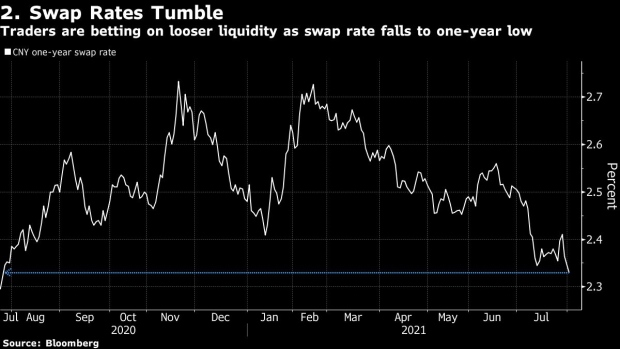Aug 2, 2021
China Traders Add to Bets on Easing as Economic Prospects Dim
, Bloomberg News

(Bloomberg) -- Listening to the chatter among China traders, the central bank is moving ever closer to another round of easing.
Investors are boosting wagers on lower borrowing costs in both the rates and derivatives markets after a key factory gauge fell in July and virus cases spiked. A Politburo meeting last week seemed to confirm bets on easing, with leaders vowing to keep liquidity ample. Benchmark bond yields and an indicator of future rates are both at one-year lows.
“Moderating activity and a likely targeted policy approach mean that a further cut in the reserve-requirement ratio in the second half appears increasingly likely,” said Mitul Kotecha, chief emerging markets Asia & Europe strategist at TD Securities in Singapore. China’s bonds “will likely remain supported,” he said.
The next window for the People’s Bank of China to add to monetary easing appears to be in about two weeks’ time, when 700 billion yuan ($108 billion) of medium-term policy loans mature. To add accommodation, the authorities may opt to inject more liquidity than the amount coming due, or even go as far as to cut the interest rate on the loans.Here are four charts looking at the growing momentum for monetary easing in Chinese money markets:
China’s sovereign bonds have rallied for seven straight weeks, and are on course for an eighth based on Monday’s performance. The benchmark 10-year yield has fallen nearly 50 basis points from its February high, bolstered by foreign inflows and bets on further easing after a surprise cut in the reserve requirement ratio that took effect on July 15. Bonds have also been boosted by haven demand triggered by a selloff in stocks.
Traders are adding to bets on monetary easing via interest-rate swaps. The rate on one-year contracts has fallen to the lowest level in a year, pricing in expectations for increasing liquidity over that period.
“There will likely be another one or two RRR cuts this year, but I don’t think there will be any rate cut,” said Larry Hu, head of Greater China economics at Macquarie Group in Hong Kong. An RRR cut would be a tool to replenish liquidity as more policy loans in the medium-term lending facility will mature in the second half, he said, adding that would be fine-tuning of monetary policy rather than a new easing cycle.
For banks with AAA ratings, it has become cheaper to borrow cash from the market than from the central bank’s medium-term lending facility. The spread between one-year AAA rated negotiable certificates of deposit and the PBOC’s one-year MLF rate widened to the most in about a year on Friday.
The PBOC’s willingness to add liquidity into the banking system, as seen by the two straight days of injections at the end of July, is having an impact on short-term money-market rates. The benchmark seven-day interbank borrowing rate has fallen back below the PBOC’s seven-day reverse repo rate.
©2021 Bloomberg L.P.